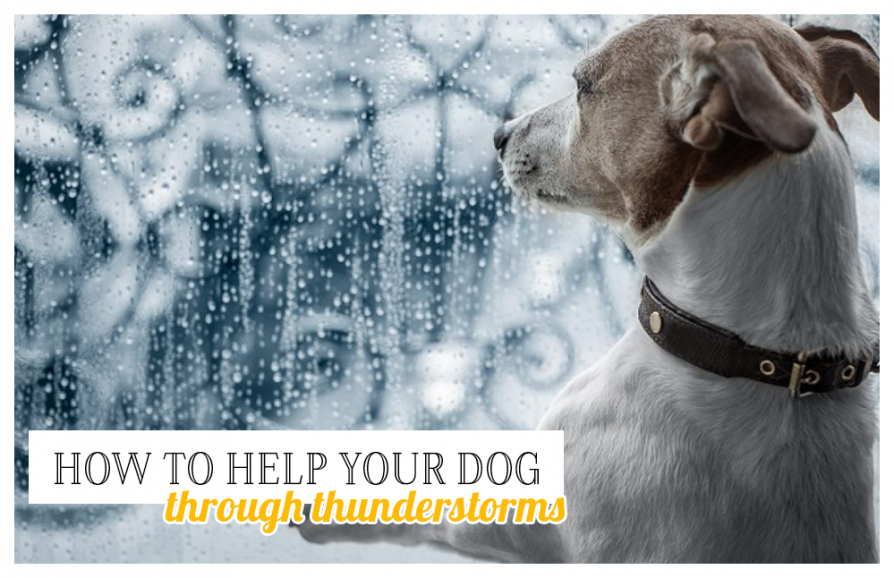How to take care of your dog during thunderstorms
- August 7th 2020

Most of us have been spending this monsoon season indoors, safe from the rain and any associated diseases. Thunderstorms, then, are just another natural marvel for us – something to enjoy and even gawp at when it’s accompanied by glorious lightning.
Your dog won’t feel the same. Most dogs are petrified of thunder, and thunderstorms can find them cowering under the nearest chair, whimpering. There’s no consensus on why thunderstorms scare dogs so much. Vets have hypothesised that it is for the same reason that fireworks can be scary: the sounds are loud and unpredictable and are often accompanied by flashes of light (in the case of thunderstorms, these flashes of light are lightening).
It’s also important to remember that dogs have more sensitive hearing than us, so the sounds are louder for them. And some breeds have even better hearing than others, which can make thunderstorms terrifying.
How can you help?
If your dog is scared of thunderstorms, then there are precautions and steps you can take to make the ordeal easier for them. As with any animal or person that is scared, love and patience are the most important elements to being supportive.
1. Don’t leave them outside.
This goes without saying, but it’s always best to emphasise the basics: don’t leave your dog outside in a thunderstorm. If they are scared of the storm, being outside will make them feel exposed and vulnerable. The rain will only add to their misery and compound their fear. It’s important for your dog to be at home and in a safe space when the thunderstorm hits, so that they feel sheltered.
2. Don’t leave them alone
This step can often be skipped, as pet parents may not think much of leaving their dog alone inside the house. But when a thunderstorm hits, it’s important that your dog is not alone. They need to feel safe and protected – for them, you are that safety. Leaving them alone may add separation anxiety to their terror and may make things much, much worse for them.
Show your pet you are right there each time thunder strikes. Make soothing noises and remind them that they are loved and should not panic.
3. Find a safe space
Each dog will have a corner of the house that they particularly love, a corner that they can call their own. If your dog is crate trained, then the crate is likely to be their safe space. Allow them to crawl in and curl up – leave the door open so that they do not feel trapped. Drape a blanket over the crate to cut out the noise and put your dog’s favourite toys in there with them, so that they feel surrounded by happy things.
If your dog doesn’t have a crate, then there is likely a place that they will crawl towards when a storm hits. Notice what that place is and make sure they have access to it. It could be a bathroom, or a room that’s particularly shielded from the noise of the thunderstorm or a room without windows. Make sure you arrange that room with things to make them comfortable: their favourite blanket, toys – whatever makes them feel safe.
4. Drown out the noise
This is simple but effective – sometimes it helps to just drown out the sounds of thunder. Play the TV on loud or put on some soothing music. Dogs usually know those sounds as human sounds, noises they can expect from living with you. That’s less scary that the boom in the sky.
5. Acclimatisation
There isn’t much you can do during a thunderstorm except be there for your dog and show them that they are loved. But you can try and acclimatise your dog to the sounds of thunder for the rest of the year. Play thunder noises on your laptop on low in the house, just so that your dog can familiarise themselves with the sound. In time, they may learn that there is nothing to be afraid of.
If your dog doesn’t respond well to these artificial thunder noises, then check with your vet on what the best way forward is. Some dogs have a deep phobia of thunder and it will need to be managed out carefully.
Talk to your vet
If your dog becomes a shaking mess of a pet during thunderstorms, then it’s important to talk to your vet. Your dog may be suffering from a number of conditions: they could be sensitive to sound, to light, they could have noise anxiety, storm anxiety, separation anxiety… The list goes on. It’s important for your vet to identify what the exact cause is and work with you to make it better. Dog phobias of thunder and fireworks can get worse as your dog grows older, not better, so it’s important to manage it at as early a stage as possible.
Comments
No posts found
